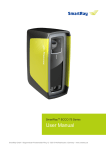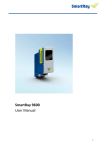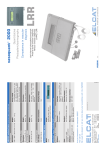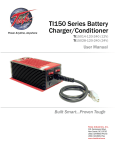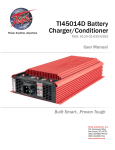Download User Manual
Transcript
SmartRayTM ECCO 35 / ECCO 55 Series User Manual SmartRay GmbH BürgermeisterFinsterwalderRing 12 82515 Wolfratshausen | Germany www.smartray.de User Manual Legal notice Legal notice Impressum © 2014 SmartRay GmbH BürgermeisterFinsterwalderRing 12 82515 Wolfratshausen Germany Tel.:+49 8171 9683 400 Fax: +49 8171 9683 401 Email: [email protected] Original User Manual Document history 1.0 Version Date Change 1.0 11/14/2014 Initial creation SmartRayTM ECCO 35 / ECCO 55 Series 2 / 48 User Manual Table of contents Table of contents 1.0 1 About this user manual ........................................................................................ 5 1.1 General.................................................................................................................... 5 1.2 Symbols and signal words ...................................................................................... 5 1.3 Abbreviations........................................................................................................... 7 2 Safety...................................................................................................................... 8 2.1 Intended use ........................................................................................................... 8 2.2 Devicespecific safety instructions .......................................................................... 9 2.3 Warning against laser beams.................................................................................. 9 Safety review...................................................................................................... 9 Laser safety...................................................................................................... 10 Laser classes ................................................................................................... 10 Laserspecific regulations................................................................................. 11 2.4 ESD protection ...................................................................................................... 12 3 ECCO 35 / ECCO 55 at a glance ......................................................................... 13 3.1 Overview ............................................................................................................... 13 3.2 Working principle................................................................................................... 14 3.3 Description ............................................................................................................ 15 Sensor views (front | side) ................................................................................ 15 Technical data .................................................................................................. 17 Dimensional drawing ........................................................................................ 19 3.4 Coordinate system ................................................................................................ 20 3.5 Calibration ............................................................................................................. 21 3.6 Order numbers ...................................................................................................... 22 4 Installation ........................................................................................................... 23 4.1 Mounting the sensor.............................................................................................. 23 4.2 Connecting cables................................................................................................. 25 4.3 StarterKit Software ................................................................................................ 28 4.4 Stepbystep installation ........................................................................................ 29 5 Get started ........................................................................................................... 31 5.1 Connection Setup.................................................................................................. 31 5.2 Capturing Data ...................................................................................................... 32 5.3 Image types........................................................................................................... 33 Live Image........................................................................................................ 33 NonCalibrated 3Dimage data types ............................................................... 34 Calibrated 3Dimage data types....................................................................... 36 5.4 Troubleshooting .................................................................................................... 40 6 Maintenance and repair ...................................................................................... 42 6.1 Maintenance.......................................................................................................... 42 6.2 Repair work ........................................................................................................... 43 SmartRayTM ECCO 35 / ECCO 55 Series 3 / 48 User Manual Table of contents 7 Decommissioning ............................................................................................... 44 7.1 Dismantling............................................................................................................ 44 7.2 Storage.................................................................................................................. 45 7.3 Disposal................................................................................................................. 45 8 Customer service/Support ................................................................................. 46 8.1 Customer service and support address ................................................................ 46 Index ..................................................................................................................... 47 1.0 SmartRayTM ECCO 35 / ECCO 55 Series 4 / 48 User Manual About this user manual 1 About this user manual 1.1 General Target group This user manual is intended to help system integrators working in the field of 3D ma chine vision in the setup, installation and operation of SmartRay ECCO 35 and ECCO 55 3D sensors. The information in this user manual enables users or employees with the rel evant experience to mount and operate the sensor. Important note The safe mounting, installation and commissioning of the sensor assumes knowledge of this user manual. It is essential, therefore, to read through this user manual – and the safety and warning instructions in particular – before beginning work. 1.2 Symbols and signal words The following symbols and signal words are used in this user manual. Safety instructions/Warnings Safety instructions consist of the following five elements: ● Danger symbols ● Signal word ● Description of the danger ● Possible consequences ● Measures for avoidance SIGNAL WORD Description of the danger. Possible consequences. ● Measures for avoidance. Safety symbol 1.0 Signal word Meaning DANGER This signal word is used to indicate an imminently dan gerous situation that will result in serious or fatal injury if not avoided. WARNING This signal word is used to indicate a potentially danger ous situation that could result in serious or fatal injury if not avoided. SmartRayTM ECCO 35 / ECCO 55 Series 5 / 48 User Manual About this user manual Safety symbol Signal word Meaning CAUTION This signal word is used to indicate a potentially danger ous situation that could result in minor or moderate injury if not avoided. ATTENTION This signal word without a warning symbol is used to indicate potential danger of damage to property. NOTE This signal word indicates additional useful information for the reader, such as operating tips or crossreferences. Other symbols for further information Important information that must be observed to avoid problems with the sensor. Further information that simplifies your work with the SmartRay sensor is marked with this symbol. Crossreferences to other documents are marked with this symbol. 1.0 SmartRayTM ECCO 35 / ECCO 55 Series 6 / 48 User Manual About this user manual 1.3 1.0 Abbreviations Abbreviation Description 2D/3D 2dimensional/3dimensional API Application Programming Interface BG German employer's liability insurance association BGR German employer's liability insurance association rules CW Continuous Wave DIN German Industrial Standards EMC Electromagnetic Compatibility EN European Norm ESD Electrostatic Discharge FOV Field of View GND Ground IEC International Electrotechnical Commission IO Input/Output ISO International Organization for Standardization LED Light Emitting Diode MR Measurement Range PIL 3DProfile, Intensity, LaserLineThickness RMA Return Material Authorization SDK Software Development Kit SO Standoff Distance SR SmartRay VDE German Association for Electrical, Electronic & Information Tech nologies ZIL ZMap, IntensityZMap, LaserLineThicknessZMap SmartRayTM ECCO 35 / ECCO 55 Series 7 / 48 User Manual Safety 2 Safety 2.1 Intended use Fields of application The SmartRay ECCO 3D sensor is designed for use in the industrial image processing sector. It can be used for: ● Quality inspection ● Metrology ● Robot guidance ● Reverse engineering The SmartRay ECCO 3D sensor may only be operated within the values specified in the technical data. See the Description, page 15 section. Nonintended use Any other use or use beyond that intended is deemed to be nonintended use. In the event of modification or reconstructions, operational safety is no longer ensured. Safe operation For the correct, safe and professional use of the SmartRay ECCO 3D sensor, it is essen tial to be familiar with and to heed the respective corresponding safety regulations and in formation. NOTICE ● Therefore, before commissioning your SmartRay sensor, carefully read through the separate SmartRay – General laser safety information and the Safety chapter of this user manual. ● It is essential to heed to warnings and information listed here. 1.0 SmartRayTM ECCO 35 / ECCO 55 Series 8 / 48 User Manual Safety 2.2 Devicespecific safety instructions WARNING Danger of injury from improper handling of the sensor. Noncompliance with these instructions can cause injury. ● The operating company using the ECCO 3D sensor is responsible to ensure a safe implementation of the sensor into the designed applica tion. This includes necessary protective devices and instructed person nel. ● Only operate the sensor in a flawless, properly functioning state. ● Ensure that the sensor is regularly checked for proper functioning. ● Maintenance work and troubleshooting must be carried out by trained, authorized qualified personnel. ● Unauthorized constructional modifications can have an adverse effect on safety. 2.3 Warning against laser beams Safety review WARNING Danger of injury from laser beams. The laser comply with class 2M. Laser power 15 mW Wavelength of 660 nm Looking directly into the beam for a time period of more than 0.25 s or re peatedly looking into the laser beam of class 2M laser products can lead to eye injuries. ● Observe the laser safety regulations (see information in document SmartRay – General laser safety)! Obligations of the operating company For safety reasons, the operating company of the 3D laser system has important duties to ensure safety during operation. In particular, the following applies: ● Cordoningoff of the laser area. ● Clear marking of the laser area. ● Operation of the laser with the minimum required power. ● Carrying out of work on the laser measurement system only by specially trained per sonnel. ● Checking of the laser protection safety measures by a laser safety officer. 1.0 SmartRayTM ECCO 35 / ECCO 55 Series 9 / 48 User Manual Safety NOTICE In addition to the information given on the topic of laser safety in this user manual, also heed the separate information in the SmartRay – General laser safety and the Laser safety chapter. Laser safety The tight bundling of the laser beam means the entire energy of the radiation is concen trated on a small crosssection. If a person is hit by the beam, this can cause damage to health. Depending on the wavelength of the laser, the beam can reach the retina and damage it. According to the potential hazard, lasers or devices that contain a laser are divided into classes in accordance with EN 60 825 "Safety of laser products". The SmartRay ECCO 3D sensor belongs to class 2M. NOTICE ● The laser class of the sensor can be found on the label of the sensor. ● The laser classes listed in the following comply with the standard DIN EN 608251 (VDE 08371):200805 October 2007 release. Due to the tight bundling and the associated high power density of the laser beams, the beams in more powerful laser products can be damaging to health. This also applies to reflections on glass surfaces and metallic or polished surfaces. Laser classes Laser class 2M The available laser radiation of laser products of class 2M lies in the visible spectral range (400 nm to 700 nm). In laser products of class 2M, there is a comparable hazard to laser products of class 2 provided no optical instruments (e.g. magnifying glass or microscope) are used that re duce the beam crosssection. CAUTION Danger of injury from laser beams. Looking directly into the beam for a time period of more than 0.25 s or re peatedly looking into the laser beam of class 2M laser products can lead to eye injuries. ● If laser radiation of class 2M hits the eyes, consciously close your eyes and immediately turn away. 1.0 SmartRayTM ECCO 35 / ECCO 55 Series 10 / 48 User Manual Safety Laser class 3B The available laser radiation lies in the wavelength range of 302.5 nm to 106 nm and is dangerous to the eyes, frequently also to the skin. WARNING Danger of injury from laser beams. Looking directly into the beam in laser products of class 3B is dangerous! ● Observe the laser safety regulations. ● When working on the sensor, wear the laser protection glasses pro vided for this purpose. Laserspecific regulations Labeling of the laser classes (laser warning labels) According to section 5.8 DIN EN 608251, laser products of classes 2 to 4 must be identi fied on a label by data about the maximum initial values of the laser radiation, the emitted wavelength and (if applicable) the pulse duration. Example of the labeling of a laser: Laser class 2M Laser class 3B Measures for laser class 3B According to DIN EN 608251, a system with a laser of class 3B must fulfill the following: ● All directives of the preceding laser classes (technical expertise, labeling, access re strictions among other things) apply ● Nomination of a laser safety officer ● An installed signal lamp must indicate the operating status of the laser 1.0 SmartRayTM ECCO 35 / ECCO 55 Series 11 / 48 User Manual Safety ● Remotecontrolled locking system ● Key switch ● Beam attenuator ● Eye protection (if constructive and organizational measures are not practicable) WARNING Danger of injury from improper handling. Noncompliance with these instructions can cause injury. ● Do not use reflective tools during adjustment work and do not wear any reflective objects (e.g. jewelry). ● Where applicable, national directives and measures that are not listed here must be fulfilled. 2.4 ESD protection ATTENTION Because the sensor is a sensitive electronic part, it can be destroyed by improper handling. ● Only carry out assembly in accordance with the applicable ESD protec tive measures. Manufacture and checking by SmartRay The sensors are manufactured and checked on the SmartRay premises under stringent ESD protective measures (according to IEC 6134051). These protective measures are already demanded from and complied with by our suppliers. The sensors are sent in ESDconform packaging. This protects the contents from electrostatic charges. Recommendations for handling the sensors Recommendation for ESD handling: ● Ground the service personnel and work area during assembly and/or repair work. ● Avoid contact with the connector contacts. ATTENTION Because the sensor is a sensitive electronic part, it can be destroyed by improper handling. ● Keep the original packaging so you can use it for sending the sensor back for repair if necessary (ESD protection). 1.0 SmartRayTM ECCO 35 / ECCO 55 Series 12 / 48 User Manual ECCO 35 / ECCO 55 at a glance 3 ECCO 35 / ECCO 55 at a glance 3.1 Overview This section describes how the sensor is constructed, the typical fields of application and the working principle. System components A functioning sensor system consists of the following components: ● SmartRay ECCO 3D sensor ● PowerI/O cable ● Ethernet cable ● Encoder cable (optional) ● StarterKit Software with a "Getting Started" installation guide (PDF) ● USB stick with calibration file (Lookup table, *.lut) Sensor series The following types of models of the ECCO 35 and ECCO 55 sensor series are available: ● ECCO 35 Series – ECCO 35.050 – ECCO 35.100 ● ECCO 55 Series – ECCO 55.020 – ECCO 55.050 – ECCO 55.100 1.0 SmartRayTM ECCO 35 / ECCO 55 Series 13 / 48 User Manual ECCO 35 / ECCO 55 at a glance 3.2 Working principle Function SmartRay 3D sensors measure distances based on the laser triangulation principle. The 3D sensor projects a laser line onto the object which is reflected back onto an image sensor. Due to the triangulation angle between the laser line, object and the image sen sor, the reflected laser line appears at different positions on the image sensor depending on different distances to the measured object. In other words, the 3D sensor measures the profile of the object, and scanning the object renders a 3Dmodel of the object! The calibration methods developed by SmartRay allow for measurements in the micro meter range! Schematic diagram of laser triangulation Laser Sensor view Im ag Le er ns Object 1.0 SmartRayTM ECCO 35 / ECCO 55 Series 14 / 48 User Manual ECCO 35 / ECCO 55 at a glance 3.3 Description Sensor views (front | side) The following figures show the sensor from the front and side: 1 2 3 6 4 5 7 1 2 3 4 5 6 7 1.0 Alive LED – L1 Status LED – L2 Camera front glass Laser warning label Laser output Housing Nameplate SmartRayTM ECCO 35 / ECCO 55 Series 15 / 48 User Manual ECCO 35 / ECCO 55 at a glance Sensor view (rear) The following figure shows the sensor from the rear with its electrical connectors: 8 9 10 12 11 8 9 10 11 12 1.0 PowerI/O connector (8pin male) Ethernet connector (8pin female) Encoder connector (5pin female) Borings for dowel pin (3m6) Threaded holes for M4 screws SmartRayTM ECCO 35 / ECCO 55 Series 16 / 48 User Manual ECCO 35 / ECCO 55 at a glance Technical data Sensor specification Technical data ECCO 35 Series Model ECCO 35.050 Maximum scan rate [KHz] 0.5 Measurement range [mm] 60 Field of view [mm] (near | mid | far) 41 | 49 | 57 1.0 ECCO 35.100 100 61 | 82 | 103 Standoff distance [mm] 150 Typical lateral resolution [µm] 57 – 80 82 – 135 Typical vertical resolution [µm] 8.5 – 16.5 11.5 – 32.5 Maximum points / 3Dprofile 752 Interface Fast Ethernet (100 Mbit/sec) Inputs 4 x Inputs, 10 24 VDC | Quadrature Encoder (ABChannel, RS422 standard) Outputs 2 x Outputs, 24 VDC Input voltage | Power 24 VDC, ± 15 % ripple | 4.5 W Weight 180 g Laser wavelength 660 nm Laser class (standard | optional) 2M | Maximum ambient light 10,000 lx SmartRayTM ECCO 35 / ECCO 55 Series 17 / 48 User Manual ECCO 35 / ECCO 55 at a glance Model ECCO 35.050 ECCO 35.100 EMC test as per EN 6100062, EN 6100064 Vibration / Shock test as per EN 6006826, 27, 29, 64 Electrical safety as per EN 6101013 Protection class III, as per EN 610403 Enclosure rating IP65 Air humidity Maximum 90 %, noncondensing Temperature (operation | storage) 0 – 40 °C | 20 – 70 °C Technical Data ECCO 55 Series 1.0 Model ECOO 55.020 ECCO 55.050 ECCO 55.100 Maximum scan rate [KHz] 6 Measurement range [mm] 20 60 100 Field of view [mm] (near | mid | far) 22 | 24 | 26 58 | 69 | 81 88 | 118 | 148 Standoff distance [mm] 70 150 Typical lateral resolution [µm] 35 40 85 – 115 136 – 228 Typical vertical resolution [µm] 3.25 – 4.75 13.5 – 27 19 – 53.5 Maximum points / 3Dprofile 640 Interface Fast Ethernet (100 Mbit/sec) Inputs 4 x Inputs, 10 24 VDC | Quadrature Encoder (ABChannel, RS422 standard) Outputs 2 x Outputs, 24 VDC Input voltage | Power 24 VDC, ± 15 % ripple | 4.5 W Weight 180 g Laser wavelength 660 nm Laser class (standard | optional) 2M | Maximum ambient light 10,000 lx EMC test as per EN 6100062, EN 6100064 Vibration / Shock test as per EN 6006826, 27, 29, 64 Electrical safety as per EN 6101013 Protection class III, as per EN 610403 Enclosure rating IP65 Air humidity Maximum 90 %, noncondensing Temperature (operation | storage) 0 – 40 °C | 20 – 70 °C SmartRayTM ECCO 35 / ECCO 55 Series 18 / 48 User Manual ECCO 35 / ECCO 55 at a glance Nameplate Example: Nameplate of the ECCO 55.020 Dimensional drawing 1.0 SmartRayTM ECCO 35 / ECCO 55 Series 19 / 48 User Manual ECCO 35 / ECCO 55 at a glance 3.4 Coordinate system Definition of coordinates The three axes in the coordinate system are defined as follows: Z X Y X Y Z 1.0 Scan or transport direction Along the laser line Height or distance between the sensor and the object SmartRayTM ECCO 35 / ECCO 55 Series 20 / 48 User Manual ECCO 35 / ECCO 55 at a glance 3.5 Calibration Sensor calibration Highest accuracy of measurement is achievable thanks to a calibration procedure spe cially developed by SmartRay. Each sensor unit is individually calibrated with a variety of reference points within the field of view and measurement range. As a result, any kind of distortion and deviation is corrected, some of which are: ● Perspective distortion ● Lens distortion ● Laser nonlinearity ● Manufacturing tolerances Sensorspecific calibration data The result of calibration is saved onto a "calibration file" which is shipped along with each sensor on a USB stick. The calibration file is basically a lookup table, often simply re ferred to as LUT and has a file extension '*.lut'. The data from the sensor along with the combination with the calibration file gives the ad vantage of generating your data in real world coordinate dimensions, i.e. in millimeters. NOTICE In case you misplaced your USB stick, i.e. lost your calibration file, please get in touch with SmartRay Customer Care via [email protected] . 1.0 SmartRayTM ECCO 35 / ECCO 55 Series 21 / 48 User Manual ECCO 35 / ECCO 55 at a glance 3.6 Order numbers ECCO 35 Series Model Order number ECCO 35.050 3.002.005 ECCO 35.100 3.002.010 ECCO 55 Series Model Order number ECCO 55.020 3.002.095 ECCO 55.050 3.002.105 ECCO 55.100 3.002.110 Designation Order number PowerI/O cable (Standard | 5 m) 6.310.005 PowerI/O cable (Standard | 10 m) 6.310.010 Ethernet cable (5 m) 6.302.005 Ethernet cable (10 m) 6.302.010 Encoder cable (2 m) 6.306.010 Accessories NOTICE In regard to the subsequent use of accessories, please get in touch with your contact person at SmartRay. 1.0 SmartRayTM ECCO 35 / ECCO 55 Series 22 / 48 User Manual Installation 4 Installation 4.1 Mounting the sensor Preparation Prepare an appropriate holder (e.g. on the robot, assembly line). For hole pattern dimensions, see section Description, page 15. Procedure Proceed as follows in order to mount the sensor on the holder provided: Step 1 Action Unpack the sensor and cables. ATTENTION Keep the original packaging so you can use it to send the sensor back for repair if necessary (ESD protection). 2 Fix the sensor in place on the holder (fixing holes). Tightening torque: 4 Nm. 1.0 SmartRayTM ECCO 35 / ECCO 55 Series 23 / 48 User Manual Installation Sensor orientation NOTICE The sensor must be mounted to the object at a certain distance. This "Standoff distance (mid)" is measured from the front of the sensor to the center of the object and can be looked up in the technical data of the sen sor under "Field of view". 1 2 3 4 5 6 7 8 1 2 3 4 5 6 7 8 1.0 PowerI/O cable Ethernet cable Encoder connector (optional) Mounting screw Stand / Holder 3D sensor Standoff distance (mid) Object SmartRayTM ECCO 35 / ECCO 55 Series 24 / 48 User Manual Installation 4.2 Connecting cables Connections and displays The following figure shows the sensor from the rear with its electrical connections and displays: 1 2 8 9 10 12 11 1 2 8 9 10 11 12 Alive LED – L1 Status LED – L2 PowerI/O connector Ethernet connector Encoder connector (optional) Borings for dowel pin (3m6) Threaded holes for M4 screws Terminal assignment 8pin powerI/O cable Pin assignment 1.0 SmartRayTM ECCO 35 / ECCO 55 Series 25 / 48 User Manual Installation Description of cable wiring Pin Wire color Brief designation Meaning/Description Pin 1 White 0 V (24 V return) Operating voltage Pin 2 Brown +24 V Operating voltage + Pin 3 Green Output 0 24 V Pin 4 Yellow Output 1 24 V Pin 5 Gray Input 0 10 … 24 V Pin 6 Pink Input 1 10 … 24 V Pin 7 Blue Input 2 10 … 24 V Pin 8 Red Input 3 10 … 24 V Description of the inputs and outputs Pin Brief designation Meaning/Description Pin 3 Output 0 Custom use via SmartRay API Pin 4 Output 1 Custom use via SmartRay API Pin 5 Input 0 Custom use (unused Inputs must be con nected to GND) Switches the laser power ON/OFF: ● When powering up the device, the laser is activated briefly at the low level setting. ● The laser can be deactivated any time re gardless of the input signal via software. Pin 6 Input 1 Custom use (unused Inputs must be con nected to GND) Pin 7 Input 2 Custom use (unused Inputs must be con nected to GND) Pin 8 Input 3 Custom use (unused Inputs must be con nected to GND) Terminal assignment Encoder cable Description ● SmartRay sensors can detect “ABChannel” triggers generated from an external incre mental encoder, which is conform to the RS422 standard. ● The maximum (idle) voltage between A+/A and B+/B must not exceed 5 V. ● There is a terminating resistor of 120 Ω between A+/A and B+/B. ● For cable lengths over 2 meters, a twisted pair electrical connection should be used. ● The wiring colors are based on a standard 5pin connector lead, as described below. 1.0 SmartRayTM ECCO 35 / ECCO 55 Series 26 / 48 User Manual Installation Pin assignment Description of cable wiring Pin Wire color Brief designation Meaning/Description Pin 1 White A+ Input A+ Pin 2 Brown A Input A Pin 3 Green B+ Input B+ Pin 4 Yellow B Input B Pin 5 Gray GND 100 kΩ connected to GND Bending radius/Strain relief device of the cables Schematic representation The following image shows the strain relief device and bending radius of the cables: Cable strain relief Bend radius 1.0 SmartRayTM ECCO 35 / ECCO 55 Series 27 / 48 User Manual Installation Bending radius ATTENTION Danger of damage to the cables. Going below the minimum bending radius results in damage to the cables and can lead to faulty transfer of signals and data. Any damage leads to mandatory replacement of the cables. ● Adhere to the minimum admissible bending radius. The typical bending radius to be used is shown in the following table: Minimum bending radius (d = diameter) Type Formula Minimum bending radius for SmartRay cables (d = 7.8 mm) Fixed 5 x d 39.5 mm Freely moving 10 x d 79.0 mm Constantly moving 12 x d 94.8 mm Strain relief device If the cables are constantly in motion (operating on the robot/an axis), it is important to ensure that a strain relief device which does not allow transverse and tractive forces on the connector and socket of the sensor is mounted. ATTENTION Danger of damage to the cables. A missing strain relief device will result in damage to the cables and can lead to the faulty transfer of signals and data. Any damage leads to mandatory replacement of the cables. ● Mount a strain relief device if the cables are permanently moving. 4.3 StarterKit Software The StarterKit Software is part of the sensor delivery. The software has to be installed on the host computer to be able to configure and communicate with the sensor. For installation of the StarterKit Software see SmartRay document Getting Started. This installation guide is part of the sensor delivery (PDF). 1.0 SmartRayTM ECCO 35 / ECCO 55 Series 28 / 48 User Manual Installation 4.4 Stepbystep installation Connecting the sensor and establishing readiness for operation Proceed as follows in order to connect the sensor and to establish readiness for opera tion: Step Action 1 Schematic Check that the sensor maintains the correct "standoff dis tance" between sensor and object. NOTE It is recommended to keep a distance (standoff distance), ac cording to the technical specifications of the sensor model. 2 Connect the PowerI/O cable to the socket (11) on the mounted sensor. NOTE Do not power on the sensor. 3 Connect the Ethernet cable to the socket (10) on the mounted sensor. 4 Connect the Ethernet cable to the host computer. 5 Optional: Connect the encoder cable to the socket (9) of the sensor. 6 If necessary, attach a strain relief device. When laying the cables, pay attention to compliance with the minimum bending radius. 7 Connect the PowerI/O cable to a 24 V power supply. 8 Apply the supply voltage. 9 Check readiness for operation. NOTE ● The Alive LED (1) indicates whether the sensor is supplied with supply voltage. ● If the LED flashes, the sensor is supplied with suppy volt age and ready for operation. 1.0 SmartRayTM ECCO 35 / ECCO 55 Series 29 / 48 User Manual Installation Step Action 10 Schematic Install the StarterKit Software to start capturing data from the sensor. NOTE See installation guide Getting Started. Alive LEDL1 The Alive LED (1) indicates the following operating states of the sensor: Alive LED Meaning Green (flashing fast) As soon as the supply voltage is applied. Green (flashing slow) Upon successful network connection. Red (permanently lit) In the event of an error. LED Meaning Green Physical Ethernet connection established. Orange 2.5 V threshold used for Input 0/1/2/3 Status LEDL2 (otherwise 10 Volt threshold). Red Hardware reset active; LED flashes for 20 ms after sensor power on. If the red LED is permanently lit, the sensor encountered a se rious error. 1.0 SmartRayTM ECCO 35 / ECCO 55 Series 30 / 48 User Manual Get started 5 Get started 5.1 Connection Setup General After you have mounted and powered your ECCO 3D sensor successfully, it's time to es tablish a connection between the sensor and the host computer. Prior to this, please make sure that you have installed the latest version of the "StarterKit Software" on the host computer. You can connect to the sensor using SmartRay Studio 3 or 4 (Studio 4 recommended) or 3rd party application softwares supported by SmartRay. NOTICE Make sure to configure the IP address of your computer network card to lie in the same range of the sensor's IP address. IP address of the host computer The last three numbers may not be the sensor IPaddress (e.g. 200) or 0 (see arrow). 1.0 SmartRayTM ECCO 35 / ECCO 55 Series 31 / 48 User Manual Get started Factory default ‘IP address | Port number’ The sensors shipped by SmartRay are configured with the following standard IP address and port number: ● Default IP address: 192.168.178.200 ● Port number: 40 Use the available connection manager to configure the IP address of the sensor. NOTICE For detailed information regarding the configuration of the IP address of the sensor, see the user manual of the used application software, e.g. Stu dio 4. 5.2 Capturing Data General After proper installation and connection, the sensor is ready for operation. Information on the data (images, point clouds) provided by the sensor can be found in the following section. Function The 3D sensor generates 3D data of an object line by line, and therefore a relative move ment between the sensor and/or the object is necessary to create the complete 3D model of the scanned object. Data from SmartRay 3D sensors can be grouped into 2 parts: NonCalibrated Data ● Live Image (Setup & Debug) ● 3DProfile ● Intensity ● Laser Line Thickness Calibrated Data ● Point Cloud ● Zmap ● IntensityZMap ● Laser Line ThicknessZMap 1.0 SmartRayTM ECCO 35 / ECCO 55 Series 32 / 48 User Manual Get started Coordinate types SmartRay technology distinguishes between two different kinds of coordinate systems: ● Image coordinate noncalibrated coordinates in pixels ● World coordinate calibrated coordinates in millimeters NOTICE For more detailed information regarding the structure of the image data, please refer to the SmartRay API user manual. 5.3 Image types Live Image The Live Image enables to start the capture of a live video stream from the sensor with the configured sensor parameters (ROI / Exposure / Gain, etc.). Designation Description General The Live Image represents a normal video stream (i.e. 2Dim ages type in pixel). The Live Image is very helpful in setting up the sensor parameters and debugging to assist in capturing your 3Ddata. Note Using the possibilities of your application software, you should setup the Live Image following these tips: ● not underexposed, ● not overexposed, ● optimum exposure: the laser line reflected from the object is thin and sharp. Format/Bit depth 1.0 Image / 8, i.e. 8 bits/pixel (range 0 – 255) SmartRayTM ECCO 35 / ECCO 55 Series 33 / 48 User Manual Get started Designation Description Live Image example Sensor setup Live Image 1 2 3 4 1 Stand 2 3D sensor 3 Object 4 Laser line NonCalibrated 3Dimage data types Overview The sensor offers the following NonCalibrated 3Dimage formats (in pixel e.g. in image coordinate system): ● 3DProfile ● Intensity ● Laser Line Thickness These image formats are called PIL (Profile, Intensity, LaserLineThickness). 3DProfile 1.0 Designation Description General The noncalibrated 3DProfile image is an image, which repre sents for each pixel the height (Zdimension) of the scanned ob ject. Format/Bit depth 14, i.e. 14 bits/pixel (range 016,383) SmartRayTM ECCO 35 / ECCO 55 Series 34 / 48 User Manual Get started Designation Description 3DProfile example 3DProfile Map Graphic analysis 3DProfile Map 3DVisualisation Intensity 1.0 Designation Description General The noncalibrated Intensity image is an image, which repre sents for each pixel the greysum of the scanned object. Format/Bit depth 14, i.e. 14 bits/pixel (range 0 – 16,383) Intensity example Intensity Map SmartRayTM ECCO 35 / ECCO 55 Series Graphical analysis 35 / 48 User Manual Get started Laser Line Thickness Designation Description General The noncalibrated Laser Line Thickness image is an image, which represents for each pixel the thickness image of a laser line of the scanned object. Format/Bit depth 6, i.e. 6 bits/pixel (range 0 – 63) Laser Line Thickness example Laser Line Tickness Map Graphical analysis Calibrated 3Dimage data types Overview With the help of a calibration file, i.e. a look up table (LUT), that is unique for each and every sensor, the noncalibrated pixel coordinates (XImage, YImage) are converted to cali brated coordinates (XWorld, YWorld, ZWorld). The sensor offers the following calibrated 3Dimage formats (in world coordinates XWorld, YWorld, ZWorld with points in mm): ● Point Cloud ● ZMap ● IntensityZMap ● Laser Line ThicknessZMap These image formats are called ZIL (ZMap, Intensity, LaserLineThickness) 1.0 SmartRayTM ECCO 35 / ECCO 55 Series 36 / 48 User Manual Get started Point Cloud Designation Description General The Point Cloud is a calibrated 3D point cloud, which represents for each point the calibrated point cloud coordinates (XWorld, YWorld, ZWorld) of the scanned object. Format The calibrated point cloud coor dinates (XWorld, YWorld, ZWorld) are available in the following for mats: ● ASCII ● CSV NOTE ASCIIseparator: X_Y_Z (de limiter space separated) CSV separator: X,Y,Z (commasepa rated) or X;Y;Z (semicolon separated). 1.0 SmartRayTM ECCO 35 / ECCO 55 Series 37 / 48 User Manual Get started Designation Description Point Cloud example 3DProfile Map Designation Description General The Zmap is an image, which represents for each pixel the cali brated height (Zdimension) of the scanned object in world coor dinate system. Point Cloud ZMap NOTE The SmartRay API converts calibrated Point Cloud to a Zmap. For more information on to decode your Zmap pixels back to real world units, i.e. in millimeters, please refer to the illustration in the SmartRay API user manual, under the Chapter "Cali brated Data Control". Format/Bit depth Image (Ex: PNG format) | 16bits / pixel (range 0 – 65,535) NOTE A pixel with a value 32,768 (215) reflects a height value of 0 mm. ZMap example 1.0 ZMap SmartRayTM ECCO 35 / ECCO 55 Series Graphical analysis 38 / 48 User Manual Get started IntensityZMap Designation Description General The IntensityZMap image is an image, in which each pixel repre sents the greysum of the laser line, additionally aligned to the 3DProfile Zmap. Format/Bit depth 16, i.e. 16 bits/pixel (range 0 – 65,535) IntensityZMap example IntensityZMap Graphical analysis Laser Line ThicknessZMap Designation Description General The Laser Line ThicknessZMap image is an image, in which each pixel represents the thickness of the laser line, additionally aligned to the 3DProfile Zmap. Format/Bit depth 16, i.e. 16 bits/pixel (range 0 – 65,535) Lase Line LaserLineThicknessZMap Graphical analysis ThicknessZMap exam ple 1.0 SmartRayTM ECCO 35 / ECCO 55 Series 39 / 48 User Manual Get started 5.4 Troubleshooting What to do in the event of faults? If the sensor is not working correctly, please contact Support at SmartRay GmbH. For the address, see Customer service/Support, page 46. Frequently asked questions (FAQ) Q: How to update the firmware of the sensor? A: The firmware of a sensor can be updated using the "firmware update file (*.fup)" that corresponds to the sensor. Please get in touch with your contact person at SmartRay to get latest updates on firmware releases! Studio 3 and Studio 4 (version 4.1.0 onwards) have builtin functionality to update the firmware of the sensor. SmartRay API also provides functionality to update the firmware of the sensor. ATTENTION If one of the following situations occurs, it could render the sensor to not function anymore. In this case the sensor has to be sent back to SmartRay for repair. Therefore, when updating the firmware: ● Ensure that the "firmware update file (*.fup)" corresponds to the sen sor. ● Do not poweroff the sensor during firmware update. ● Do not update an incompatible firmware version to the sensor. Q: What do I do in case I updated the wrong firmware for the sensor? A: In the event that a wrong firmware was uploaded to the sensor, you have to send the sensor back to SmartRay for repair, after filling the RMA form. Please get in touch with your SmartRay contact person if necessary. Q: What do I do if I forgot the IP Address | Port Number of the sensor, after changing it? A: SmartRay API with versions higher than 3.6.50 provide functionality to log the 'IP Ad dress | Port Number', after it was modified successfully. This functionality is enabled by default with API version higher than 3.6.50. If you modified the 'IP Address | Port Number' of the sensor using Studio 3 or Studio 4 from StarterKit Software 3.6.50.0.0 or higher, the modified 'IP Address | Port Number' is saved in a log file called "sr_ip_modifier.log" in the same path from where you run your application, i.e. for example, from where you run your Studio 3 or Studio 4 application. 1.0 SmartRayTM ECCO 35 / ECCO 55 Series 40 / 48 User Manual Get started Q: What do I do if I misplaced the calibration file (LUT)? A: Please get in touch with your SmartRay contact person along with the "serial number" of the sensor. Q: What do I do if I am not able to establish a connection to the sensor from my com puter? A: Make sure that : ● the sensor is poweredon, ● the "Alive signal (LEDL1)" is blinking on the sensor, ● there are no loose contacts on your PowerI/O or Ethernet connectors, or on the net work switch, if used, ● the network card of your host computer is configured to lie within the same IP Address range as that of the sensor, ● not more than one software application is trying to connect to the sensor. Recommended practices CAUTION Danger of injury from laser beams Looking directly into the beam for a time period of more than 0.25 s or re peatedly looking into the laser beam of class 2/2M laser products can lead to eye injuries. ● If laser radiation of class 2 hits the eyes, consciously close your eyes and immediately turn away. ● Switch off the laser when not in use. ● Make sure that you do not mount the sensor in such a way that a direct or indirect laser reflection could harm you, or your coworkers. ● Always ensure that the sensor is transported based on ESD regulations. 1.0 SmartRayTM ECCO 35 / ECCO 55 Series 41 / 48 User Manual Maintenance and repair 6 Maintenance and repair 6.1 Maintenance Cleaning deposits Deposits (dirt, dust etc.) on the front glass of the sensor and the glass region from where the laser is omitted can affect the quality of the measurements. Therefore, regular clean ing is recommended. NOTICE Only clean the front glass of the sensor and the glass region from where the laser is omitted with a microfiber cloth and cleaning alcohol if neces sary. WARNING Danger of injury from electricity. Noncompliance with this instruction can cause injury. ● Before maintenance work, disconnect the sensor from the power sup ply. 1.0 SmartRayTM ECCO 35 / ECCO 55 Series 42 / 48 User Manual Maintenance and repair 6.2 Repair work WARNING Danger of injury from escaping laser radiation. Unauthorized constructional modifications to the sensor can have an ad verse effect on safety. SmartRay is solely responsible for repairs. Opening the housing will lead to loss of the guarantee. ● Never disassamble the sensors from SmartRay GmbH. Defective sensor or defective sensor cable In the event of a defect of the sensor or sensor cable, send in the defective product for re placement or repair. NOTICE Use the original packaging for sending back the sensor (ESD protection). Dismantling the sensor or cables Dismantle the sensor or defective cables in accordance with section Dismantling, page 44. 1.0 SmartRayTM ECCO 35 / ECCO 55 Series 43 / 48 User Manual Decommissioning 7 Decommissioning 7.1 Dismantling General Final decommissioning and disposal includes the complete uninstallation of the sensor. Dismantling the sensor/cables WARNING Danger of injury from electricity. Noncompliance with the following instruction can cause injury. ● Before maintenance work, disconnect the sensor from the power sup ply. Proceed as follows to disassemble the sensor or defective cables: Step Action 1 Disconnect the sensor from the power supply. 2 Disconnect the connected cables from the sensor connectors. 3 Remove the strain relief device and dismantle the sensor from the holder (robot etc.). 4 Unplug the cables. 5 Package and send the sensor and/or cables to SmartRay. WARNING Danger of injury from incorrect handling. Noncompliance with the following instruction can cause injury. ● Observe the relevant safety regulations and applicable accident pre vention regulations. 1.0 SmartRayTM ECCO 35 / ECCO 55 Series 44 / 48 User Manual Decommissioning 7.2 Storage Storing sensor components Proceed as follows to store the sensor components: Step 1 Action If possible, store the sensor components in the original packaging in a dry location. If the original packaging is no longer available, store the sensor covered (dust protected) in a dry location. Ambient conditions Observe the following ambient conditions during storage: 7.3 Admissible storage temperature 20 to +70 °C Relative atmospheric humidity 40 to 70%, noncondensing Disposal Procedure Proceed as follows to the dispose of the sensor and cables: Step Action 1 Dispose of the sensor and cables in an environmentally friendly manner in accordance with local provisions as well as the regulations and laws appli cable at the time of disposal. 2 Alternatively, send the sensor and cables to: SmartRay GmbH BürgermeisterFinsterwalderRing 12 82515 Wolfratshausen Germany 1.0 SmartRayTM ECCO 35 / ECCO 55 Series 45 / 48 User Manual Customer service/Support 8 Customer service/Support 8.1 Customer service and support address Return Material Authorization form For repairs related and maintenance related requests send the sensor to the following ad dress after filling out the RMA form. Support address SmartRay GmbH BürgermeisterFinsterwalderRing 12 82515 Wolfratshausen Germany Tel.:+49 8171 9683 400 Fax: +49 8171 9683 401 Email: [email protected] 1.0 SmartRayTM ECCO 35 / ECCO 55 Series 46 / 48 User Manual Index Index Numerics 3DProfile F 34 A 40 Faults 40 Fields of application Abbreviations 7 Alive LED L1 30 Ambient conditions, storage 45 B Bending radius FAQ 28 Function Calibrated 3Dimage 36 Calibration 21 13 I Image coordinate 33 Inputs 26 Installation 23 Intended use C 8 8 Intensity 35 Intensity Zmap 39 L Calibration data Sensorspecific Cleaning the front glass 21 42 Connecting cables 25 Coordinate types 33 Customer service 46 D Labeling of the laser classes 11 Laser class 2M 10 Laser class 3B 11 Laser classes 10 Laser Line Thickness 36 Laser Line Thickness Zmap 39 Decommissioning 44 Laser safety 10 Default IPaddress 32 Laser triangulation 14 Description 13 Laser warning labels 11 Dismantling 44 Disposal 45 E M Maintenance 42 Measures for laser class 3B 11 Electrical connection 25 Minimum bending radius 28 ESD protection 12 Mounting the sensor 23 Ethernet/network cable 22 N NonCalibrated 3Dimage Nonintended use 1.0 SmartRayTM ECCO 35 / ECCO 55 Series 34 8 47 / 48 User Manual Index O W Operating states 30 Working principle 14 Operational faults 40 World coordinate 33 Order numbers 22 Outputs 26 Z ZMap 38 P Pin assignment Encoder cable Power I/O cable Point Cloud 27 25 37 Port number 32 R Readiness for operation 29 Repair work 43 S Safety instructions, devicespecific 9 Sensor calibration 21 Sensor IP address 32 Sensor orientation 24 StarterKit Software 28 Status LED L2 30 Storage 45 Strain relief device 28 Support address 46 System components 13 T Target group 5 Technical data ECCO 35 Series 17 Technical data ECCO 55 Series 18 Terminal assignment Troubleshooting 1.0 25, 26 40 SmartRayTM ECCO 35 / ECCO 55 Series 48 / 48
















































